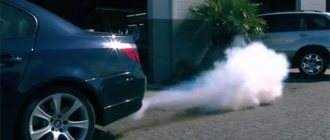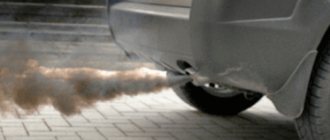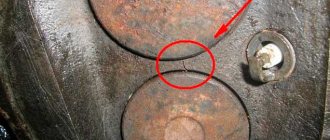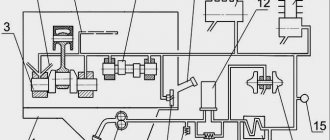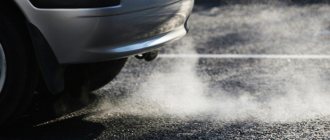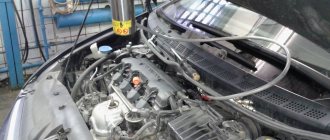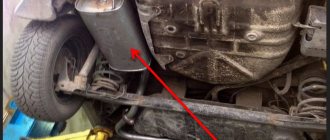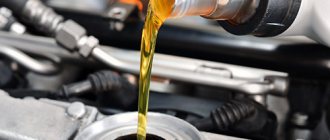Category: KAMAZ
- What does the KamAZ exhaust indicate?
- KamAZ smokes white smoke reasons
- KamAZ smokes black smoke reasons
- KamAZ smokes blue smoke reasons
- Results
The products of the Kama Automobile Plant, located in Naberezhnye Chelny, entered everyday life, became popular and distributed in forty countries. Mass popularity is the reason that the incorrect behavior of technology arouses consumer interest.
During operation of the power plant, a frequent occurrence is the abundant release of exhaust gases and the KamAZ smokes. For a working engine, this behavior is typical when starting, but it goes away after a short period of time. If not, the symptom indicates problems in the condition of the unit. The sooner the reason why the KamAZ smokes is identified and eliminated, the longer the engine will last.
KamAZ 6520 (dump truck):
What does the KamAZ exhaust indicate?
Car exhaust, an indicator of the condition of the power plant. As already mentioned, the KamAZ diesel engine does not smoke under normal conditions. Otherwise, analysis of emissions (smoke color) will answer the question about the condition of the motor. The indicator will indicate the exact cause of the breakdown, the degree of wear and condition of the components. Damage to injectors and fuel pressure pump.
Exhaust is the remains of unburned fuel coming out in the form of gas. Visually, the emission products are visible at sub-zero temperatures, then the smog is presented in the form of steam.
When KamAZ operates, there is exhaust of the following colors:
- White issue, with an admixture of black and gray tones;
- Blue edition, with an admixture of gray tone;
- Black exhaust, with soot emissions.
Blue smoke: wear of the cylinder-piston group
The most common reason that a diesel engine produces blue smoke is wear of the cylinder-piston group and timing parts. Oil entering the combustion chamber may occur due to increased piston ring gaps, gaps between valve stems and guide bushings. Damage may occur on the cylinder liner; rings, piston grooves, etc. may be destroyed.
The presence of strong gaps in the area of the piston grooves causes oil to be “sucked” into the combustion chamber. This happens even taking into account the normal condition of the oil scraper rings. Additionally, the shape of the cylinder can change, which significantly reduces the sealing by means of rings. The cylinders may take on the shape of an ellipse, resulting in gaps appearing. Wear of the CPG causes loss of compression, and crankcase gas pressure also increases. When measuring compression, it must be taken into account that the oil in the cylinders can seal the gaps. It turns out that the compression in the faulty cylinder will be too high. To obtain accurate results for assessing compression and the state of the CPG, a number of specific requirements must be met.
If the CPG is not worn out much, then blue smoke is clearly visible during the engine warm-up process. After reaching operating temperature, the smoke intensity decreases or the blue diesel smoke completely disappears. This is explained by the expansion of parts as a result of heating, which causes sealing of the gaps. An example is that diesel is bad, but a repeated hot start occurs without problems.
Oil consumption increases as a result of breakage of the bridges between the piston grooves. An increase in engine oil consumption results from broken rings as a result of wear or overheating of the diesel engine. Using low quality oil and not changing it on time leads to stuck piston rings. The rings “stick” in the piston grooves, and their mobility is completely lost.
Direct (excessive oil consumption) and indirect signs help identify oil getting into the cylinders due to CPG wear. The second group includes: the appearance of noise from the operation of the engine, various knocking sounds appear with changes in speed and load on the engine, the intensity of blue or gray smoke changes as the engine warms up, unstable operation of the diesel engine is noticeable when starting “cold”.
KamAZ smokes blue smoke reasons
When analyzing exhaust gases, attention is paid to the smell accompanying the exhaust. The indicator is especially important if the exhaust is blue.
The causes of blue smoke are:
- Uneven distribution of the fuel mixture by volume. With this phenomenon, blue exhaust is accompanied by a strong odor. The fact is that the diesel in the cylinder burns partially. The unused mixture is simply thrown into the pipe. Burnt fuel ignites on the surface of the piston and head, overheating the parts. Such a process, sooner or later, leads to damage to the pistons and melting of cylinder parts.
It's all about oil
With this diagnosis, the “cloud” from the exhaust pipe will smoke from light to dark shades. It will depend on the concentration of oil that flows into the combustion chambers, engine operating conditions and warm-up temperature. At the same time, you will feel the burnt smell characteristic of the oil.
The appearance of such gas will be indicated by increased oil consumption. To solve this problem, you need to decide on suppliers of “unnecessary” fluid.
Wear of the cylinder-piston group
Very often, a diesel engine produces bluish smoke due to wear of the cylinder-piston group and timing components (gas distribution mechanism). Oil can get into the cylinder for several reasons.
- The piston ring clearances have been increased.
- The gaps between the valve stems and guide bushings have been increased.
- There is damage on the cylinder liner.
- The rings are destroyed.
- There are violations of the piston grooves and many other reasons.
For example, severe gap defects in the area of the piston grooves allow the combustion chamber to “suck” oil. This is possible even if the oil scraper rings are in good condition. With a long period of operation, the cylinders can change their shape, for example, become elliptical. Due to changes in shape, compaction deteriorates.
Wear of this group of parts also causes a decrease in compression. When measuring compression, it is worth taking into account the ability of the oil to seal gaps. It turns out that if the cylinder is faulty, then the compression should be too high. To carry out diagnostics of the CPG (cylinder-piston group), take measurements and obtain an accurate assessment, certain requirements must be met.
If the mechanisms do not have a very large deterioration in quality, then the notorious smoke can be seen when the engine warms up. After warming up, the level of the symptom decreases or disappears completely. This is explained by the fact that at high temperatures the parts expand and the gaps become sealed.
Results
The first thing that is done when smoke is detected from a KamAZ engine, regardless of what color the exhaust is, is: filters are changed, injectors are cleaned, and the fuel supply is adjusted. Sometimes these actions are enough to restore normal operation. In serious cases, intervention is performed on the power plant.
KamAZ, air filter:
Remember, the sudden appearance of black smoke from the engine exhaust pipe is often caused by KamAZ fuel of inappropriate quality. Replacing the fuel will solve the problem; further use of the engine on this diesel engine is prohibited.
Monitoring the condition of the belt driving the gas distribution mechanism. Adjustment of thermal clearances of valves, phases, marks, diagnostics of glow plugs. These actions will help optimize engine life and minimize operating costs.
Causes of black smoke
Black exhaust, so characteristic of diesel engines, indicates partial combustion of the fuel, while the rest of it burns out in the exhaust pipe. The cause of black smoke is considered to be a number of the following factors:
- Air filter malfunction. If the air filter becomes clogged, the amount of air in the mixture decreases, which means the efficiency of fuel combustion decreases. Replace the air filter or clean it.
- Clogged fuel injectors. Usually, carbon particles accumulate inside the injectors, which interfere with the normal supply of fuel, and therefore do not ensure its complete combustion in the chamber. To extend the life of the injectors, they can be cleaned; in other cases, they are only replaced.
- Motor overload . This happens when driving uphill when the gear is too high. When climbing, use lower gears to take the load off and allow the engine to run more efficiently.
- Incorrect fuel pump adjustment. As a rule, if the settings are incorrect, the amount of fuel supplied to the injectors increases significantly. This means that there is not enough air for its combustion, and its excess goes into the exhaust system, burning out there.
- Carbon deposits deposited in the combustion chamber. It appears most often at low engine loads. The appearance of carbon deposits can be on the valves, around them, etc. In any case, the appearance of carbon deposits is always accompanied by increased fuel consumption and black smoke.
- Oil scraper rings are stuck. In this case, in addition to black smoke, increased fuel consumption may be observed. Engine repair will cost not only replacing the rings, but also replacing the cylinders to a larger size.
- Incorrect valve mechanism adjustment . Fuel enters the combustion chamber not only when they open, but also when they are in the closed position, since the seal of the chamber is seriously compromised. Adjust the thermal clearances of the valves.
- Insufficient oil viscosity . If the oil is too thin, it easily overcomes the piston ring seals. Flush the engine and change the oil.
- Low quality fuel . The only way to fix this is by changing the gas station.
- Incorrect adjustment of the gas distribution mechanism . This means that fuel enters the combustion chamber at a time when the intake stroke has not yet begun or has already ended.
Air filter clogged
The purpose of the filter is to clean the air entering the cylinders from solid particles that can damage the engine. When it becomes clogged, the air supply is reduced, which affects engine power and fuel consumption. If the filter is clogged, fuel burns in vain. If you notice increased fuel consumption along with black smoke, check the filter first. In vehicles equipped with an on-board diagnostic system, the computer will display P0171 or P0172.
The solution to the problem is obvious - the air filter needs to be changed. Car manufacturers advise replacing filter elements every 12 months or every 10-20 thousand km. The “life” of the filter largely depends on the operating conditions of the car. On dusty dirt roads it will clog faster than when driving on smooth, clean asphalt.
The injectors are clogged
If a diesel engine smokes black smoke when cold, does not start on the first try, and stalls when you press the gas pedal, most likely the reason is in the injectors. When using low-quality fuel, tar and sludge accumulate in the spray holes. Cleaning them will help restore the functionality of the injectors. There are two ways to flush injectors:
- Chemical. A special cleaning compound (solvent) is poured into the fuel system and the engine is started several times.
- Physical. The injectors are removed from the engine and placed in a special ultrasonic bath. This method is more effective, although more expensive.
Turbocharger faulty
Black smoke from the exhaust pipe with low engine power and increased oil consumption indicates problems with turbocharging. There may be two reasons:
- air duct blockage;
- Intake/exhaust manifold leaking.
You can even diagnose an air leak by ear - when the engine is turned on, the turbocharging system emits a loud, characteristic whistle. If the turbocharger is silent, you need to turn off the engine and check the air path for blockages.
Fuel injection pump malfunctions
A diesel engine may smoke black due to an incorrectly set injection angle on the high-pressure fuel pump (HPF). The fuel-air mixture ignites with a delay. The pressure in the cylinders increases, which leads to the formation of large amounts of soot. It is better to check and, if necessary, change the injection angle in a car repair shop, since the procedure is complex and requires special equipment. There is no point in delaying this, since long-term operation of a car with an incorrectly set injection angle leads to rapid wear of the parts of the cylinder-piston group.
Another reason for diesel smoke can be wear of the injection pump plunger pairs. This malfunction is indicated by “floating” idle speed when the engine warms up.
Gray (blue) smoke from the exhaust pipe of a Cummins engine
Causes of dove (blue) smoke on Cummins:
- oil entering the cylinders from the turbine
- oil entering the cylinders through worn or broken rings
So, blue smoke appears when the turbine begins to drive oil into the cylinders. This is a very dangerous phenomenon, because, firstly, the turbocharger’s impeller may collapse and its debris may be sucked into the intake manifold and further into the cylinders. And secondly, oil getting into the cylinders can lead to such a phenomenon as engine “overrun”, when oil burns uncontrollably instead of fuel. In case of drift, it will not be possible to turn off the engine with the key, because stopping the fuel supply won't help anything, the engine runs on oil. The only way out is to cut off the oxygen supply to the cylinders. This can be done by plugging the inlet in the air filter housing.
